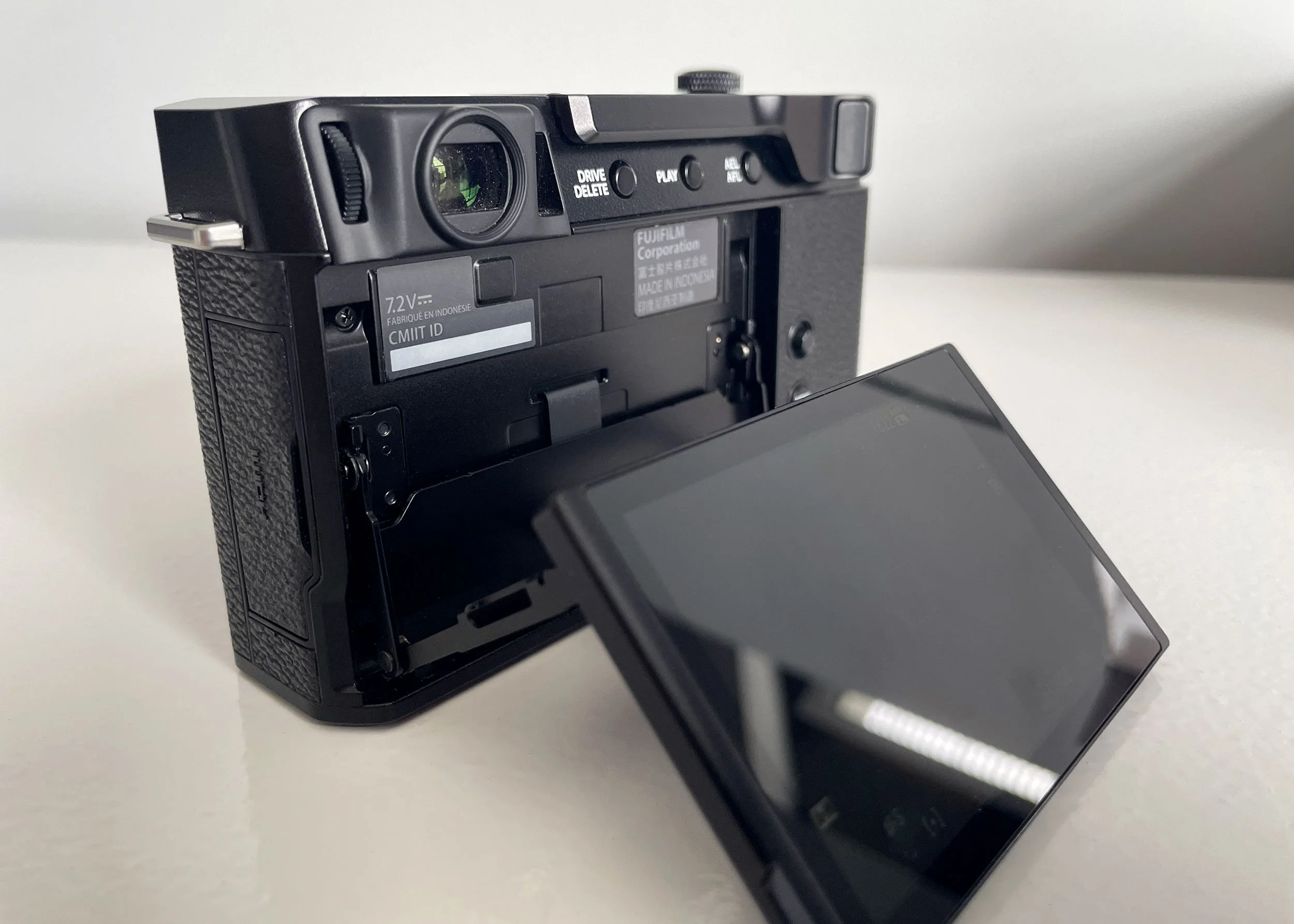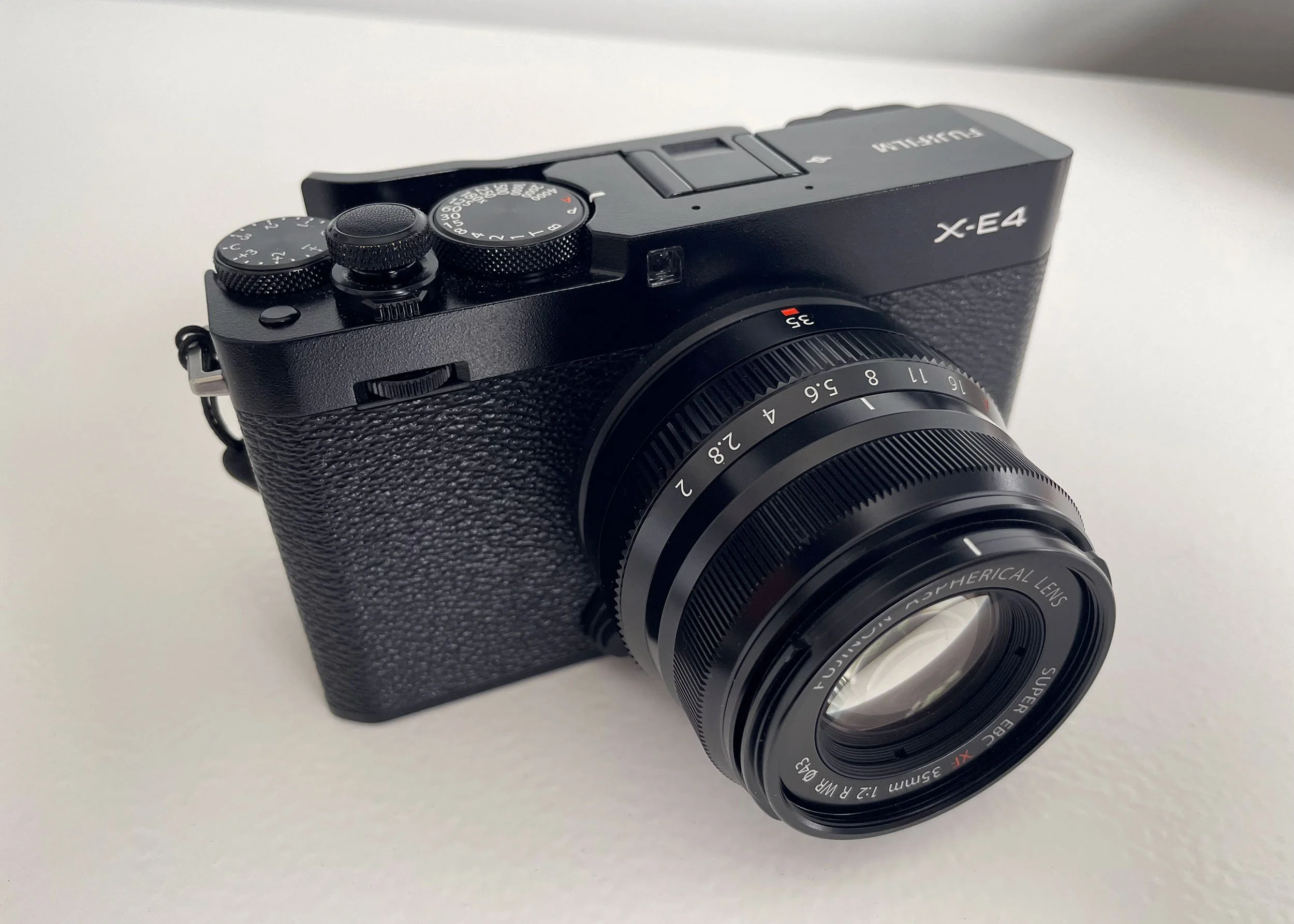Fujifilm X-E4: 18-Month Review
Fujifilm X-E4 with 35mm f/2
It may seem a little late for a review on a discontinued camera, but there is always the used market if someone is looking for an example. As I anticipate my eventual replacement for this camera, it’s time to reflect on what I consider great about the Fujifilm X-E4, what I find lacking, and where it could improve. Will the next camera in the X-E series be what I need, or will I look for something else in Fujifilm’s offering?
My previous Fujifilm camera, the X-E2, was an excellent camera for the intended purpose, and with the 18-55mm, it was smaller and lighter and a fantastic second option when I didn’t want to use the Canon 5D Mark II. After years of on-and-off use with the X-E2 (released in 2013), I finally debated replacing the camera. As I’ve always loved the results from the X-E2, Fujifilm was at the top of the list, with the current X-E model being the one I was heavily considering.
The X-E4 was released in March 2021, and I purchased it in January 2022. Since purchasing the camera, it has travelled with me to Lisbon, Porto, and London, as well as New York and Mexico twice, and it was the camera I used for my HFX Street project.
What’s Great
1. Compact and Unassuming
The X-E4’s size is on par with the X-E2 within millimetres of each other. The X-E4 comes in at 364 grams (with battery), whereas the X-E2 is 350 grams. This made the move to the X-E4 easy while having the advantage of the interchangeable 18-55mm lens, which came packaged with the X-E2. The compact form factor makes it an ideal camera as a walking camera and something I frequently have in my hand while walking around. It is quite unassuming, with a small lens attached, contributing to a look that does not attract unnecessary attention. I’ve stood in the middle of crowds in Grand Central and closely photographed people on Millennium Bridge, and I didn’t get even a glance from anyone. These are really popular locations, so I wasn’t too surprised, but I suspect the experience would be different with a larger, more professional-looking camera.
2. Image Quality
I always thought that the X-E2, with its 16MP sensor, delivered quality images, and I was always happy with them. That was taken to a new level with the X-E4 with the overall excellent image quality from the 26.1MP, X-Trans CMOS 4 sensor and Fujifilm’s X-Processor. I don’t know the technical details and how the technology contributes to the results, but the X-E4 delivers exceptional image quality with great detail, accurate colours, and excellent dynamic range. It’s also a pretty strong performer in low-light situations, and although noise will inevitably occur, it never bothered me. Street photography can benefit from some noise, and I have rarely encountered a problem in my travels where the noise level has ruined a photo. (High ISO sensitivity range of 160-12800 expandable to 80-51200)
3. Film Simulations
Fujifilm is well-known for its film simulations and the ability to create your own film “recipes,” which can factor in why people purchase Fujifilm cameras in the first place. The X-E4 allows you to save up to seven film recipes; those recipes can be renamed for easy organization. I have the recipes easily accessible through my quick menu, allowing me to switch them up when needed quickly. I usually use one film simulation/recipe per trip to keep a consistent look throughout the series, meaning I don’t need to switch them on the fly too often. Also, I use RAW+JPEG for travel to have the RAW files for further processing and different looks if needed. Still, for local street photography, I find myself choosing and experimenting with one film simulation at a time while only shooting JPEG.
Since there are hundreds of film recipes to be found and endless ways you could customize one of your own, seven presets can seem quite limited, although I find it does force me to try new simulations often. Of the seven I have saved, four of them will remain my go-to’s. I never experimented much with film simulations with the X-E2, but they have become essential to my shooting style since owning the X-E4.
Areas for Improvement
1. LCD Screen
First, I will say that the quality of the LCD screen is excellent. With 1.62M dots on a 3.0-inch screen, the photos are crisp, and the onscreen information is highly readable. Still, it can get a little busy with different amounts of information that can thankfully be customized and minimized. The touch-sensitive LCD screen can be tilted only upwards and downwards and is not a fully articulating screen, which is a feature that would be hugely useful for me as I shoot a lot of content in vertical/portrait orientation. Also, as a touchscreen, good luck tilting the screen without mistakenly selecting something you didn’t intend. As a result, I turned off all touchscreen functionality as I find it more of a nuisance than a convenience, but that means I need to go into the menu for a few things. I like having the option to tilt the screen, but I wish I could rotate it to make vertical shooting a bit easier.
2. Menus Can Be Confusing
I find the user interface confusing and a bit frustrating, and this is not limited to the X-E4, as it was a similar experience with the X-E2. With any camera with a lot of features and customizations, they need to put those options somewhere, but they are buried in levels of menus that took me some time to get used to. Conveniently, the quick menu lets you put my most accessed features in one menu as I still forget some options. I sometimes go through the menus individually, looking for what I want. This gets easier after consistent use, but even after a short hiatus of not using the camera for a few weeks, I find I need to take a few minutes to reacquaint myself with the menu. This is by no means a deal breaker on buying the camera, as I’m not sure how they could improve, but I think more thought could be put into how the menus are laid out.
3. Single SD Card Slot
The X-E4 only features a single SD card slot, which is annoying. I realize it is a small camera, but I believe an additional SD slot could be added without much of a size increase to the camera body. Having dual card slots allows for automatic backup and peace of mind, and it’s a shame that not all cameras have them.
When I travel, I back up my photos every night; I import them to my Mac and then copy them to a portable hard drive for redundancy. This process works as I’m confident my photos are backed up. If I had copies of my images on two separate SD cards, I probably would cut a step out of my backup process, and in some cases, I would leave my Mac at home. With travel, anything that contributes to less weight is good, as even a pound or two can make a difference when carrying that weight all day.
Other Thoughts
Image Stabilization
I have read that a lack of in-body image stabilization on the X-E4 is one of the common drawbacks of this camera. I think the inclusion would be beneficial, but I can’t remember when I would have needed it. It would be great, but based on my experience with the camera, I didn’t feel it should make my “areas of improvement” list. If my next camera purchase includes in-body stabilization, I’m sure this would be one of those features I can’t believe I did without.
Thumb Rest
I mentioned this in a previous post when discussing how great the X-E4 is for travel, but the thumb rest that fits into the hot shoe does not come with the camera; it is a separate purchase, and at almost $100 CA, it’s expensive. I used the camera for less than a week before I ordered the thumb rest as I feel it is a good addition for one-handed, vertical operation. Without the rest, it is not the most secure-feeling camera in your hand, although it is usable without it, and many will be completely comfortable as is. To counter that point, since the thumb rest slots into the hot shoe, it somewhat gets in the way of physical buttons such as the exposure lock and the quick menu buttons. The X-E4 could be designed better as there is not much grip overall.
Was it the Right Choice for Me?
The Fujifilm X-E4 is the fourth camera in the X-E series, and no matter how long (or if) that line continues, it will always have limitations or lack features as it is the lowest-priced camera in the X lineup. The shortcomings or areas of improvement for the X-E4 may never be corrected as more features and conveniences could continue to be reserved for the more expensive X cameras.
But the X-E4 is an excellent evolution of the X-E line, and I’m pleased with the camera and still amazed by what the camera is capable of. I can confidently say that the Fujifilm X-E4 is one of the best camera purchases I have ever made; it has allowed me to be more confident in public places with its small size and has allowed me to be more creative and experimental using film simulations and recipes.
It does have a few shortcomings, but overall, it’s a great camera and compact package, especially with the 35mm f/2 attached. Would I consider buying the equivalent replacement of the X-E4? Yes, but would I continue with the X-E series? That depends. Fujifilm offers an extensive range of cameras based on what the consumer desires.
It comes down to my cost-benefit. Can I justify the premium price for the features I want? Is the size right for me? When the time comes to replace this camera, I must consider these options. For now, I will continue to use the X-E4 for my travels and street photography and be happy with how amazing this camera is.


